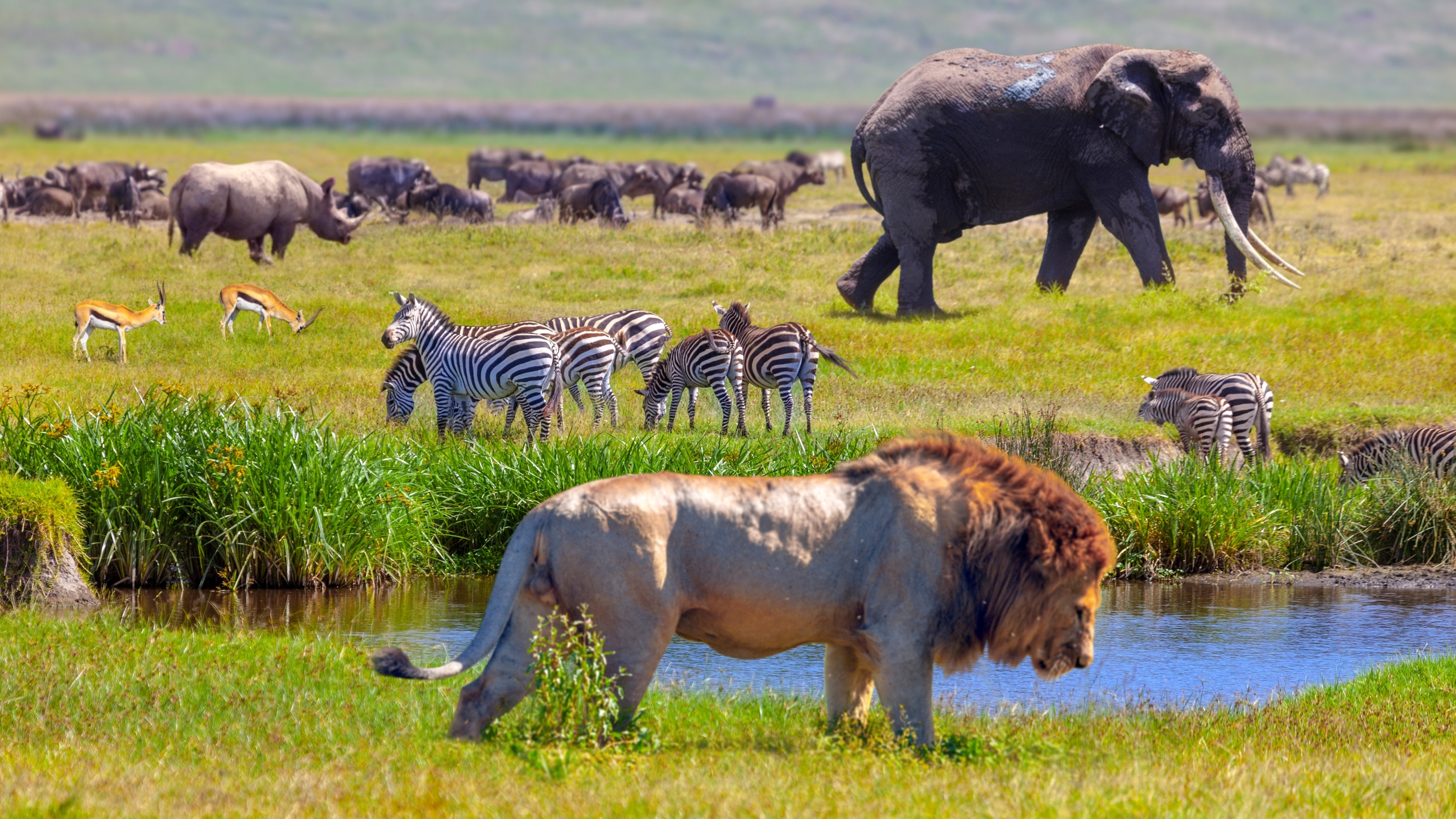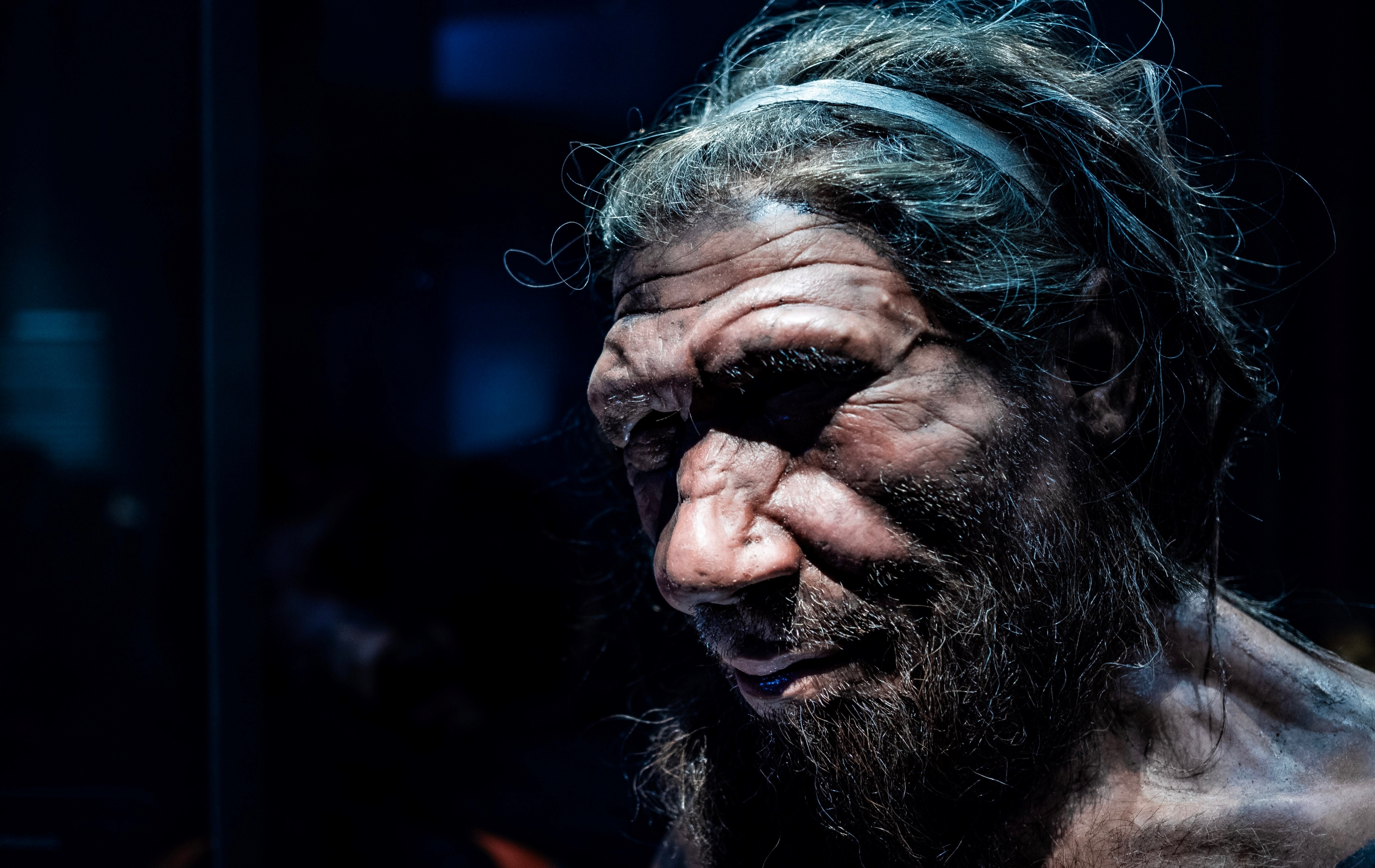How would Earth be different if modern humans never existed?
A world without modern humans could have been a land of giants.

Humanity's fingerprint can be seen across the planet today, from the towering skyscrapers that define our modern metropolises to the pyramids and other ancient monuments of our past. Human activity also marks our sprawling open fields of agriculture and the roads that link everything together. But what would the world look like if humans had never existed?
Some scientists paint a picture of a pristine wilderness and an abundance of species, from the familiar to the not so familiar. "I think it would be a much more vegetated place with a wealth of animals, of large size spread across all continents except Antarctica," Trevor Worthy, a paleontologist and associate professor at Flinders University in Australia, told Live Science.
A world without modern humans might also mean that our extinct human relatives, such as the Neanderthals, would still be around. And they, undoubtedly, also would have changed the landscape.
Related: What's the first species humans drove to extinction?
Humans have shaped the world at the expense of many species, from the dodo (Raphus cucullatus) to the Tasmanian tiger (Thylacinus cynocephalus), which we drove to extinction through activities such as hunting and habitat destruction.
The extinction rate on Earth today is more than 100 times what it would be without humans by the most conservative estimates and hasn't been higher since the Cretaceous-Paleogene (K-Pg) extinction event that wiped out about 80% of animal species, including the nonavian dinosaurs, 66 million years ago, Live Science previously reported. In other words, humans hit this planet like an asteroid, and the dust is still settling as wildlife continues to decline.
"My great, great grandfather was able to observe flocks of thousands of parakeets in the natural landscapes, my grandfather saw flocks of a hundred, my father saw a few and I'm lucky if I can see two in the forests," Worthy said.
Get the world’s most fascinating discoveries delivered straight to your inbox.
The human-led decline of nature indicates that Earth would be a much wilder place without us, with some lost giants, such as moas, sticking out more than others. This group of ostrich-like birds, some of which stretched up to 11.8 feet (3.6 meters) tall, evolved in New Zealand over millions of years. Within 200 years of humans' arrival on these birds' lands 750 years ago, all nine species of moa were gone, along with at least 25 other vertebrate species, including the giant Haast's eagles (Hieraaetus moorei) that hunted the moas, according to Worthy.
Giant moas and Haast's eagles are recent examples of large animals whose extinctions are definitively tied to human activities, such as unsustainable hunting and the introduction of invasive species into new habitats. They are also indicators of what our relationship with large animals may have been like elsewhere.
The survival of large animals is critical for speculating about an Earth without humans, as these beasts have such a heavy impact on landscapes.
Serengeti Earth

Sören Faurby, a senior lecturer in zoology at the University of Gothenburg in Sweden, believes humans played a key role in the disappearance of many large mammals going back thousands of years. He led a 2015 study, published in the journal Diversity and Distributions, which suggested that, without humans, Earth would largely resemble the modern-day Serengeti, an African ecosystem teeming with life.
Related: How long do most species last before going extinct?
In this scenario, extinct animals similar to those found in the Serengeti today — including elephants, rhinos and lions — would live across Europe. For example, instead of African lions (Panthera leo), there would still be cave lions (Panthera spelaea), a slightly larger species that lived in Europe up until about 12,000 years ago. Meanwhile, the Americas would be home to elephant relatives and massive bears, along with unique species, like car-size armadillo relatives called Glyptodon and giant ground sloths, according to Faurby.
"In a world without humans, there would be a much bigger diversity of large mammals, and if you see a larger diversity of large mammals, you tend to see a much more open habitat," Faurby told Live Science.
Elephants and other large animals are pretty determined when finding food and won't stand for unnecessary obstructions. "If you're big enough, then it might be easier to just knock over a tree and eat the fresh leaves on top," Faurby said. But also, if there are a ton of large mammals, there tends to be less wooded vegetation emerging in the first place, he added.
The hairy elephant in the room
Large animals, like elephants, are known as megafauna. During the last ice age of the Pleistocene, (2.6 million to 11,700 years ago), the world was rich in megafauna, but most died out as the ice age ended, or in the millennia since. For instance, about 38 genera of large animals went extinct in North America at the end of the last ice age, according to a 2020 study in the journal Proceedings of the National Academy of Sciences. For the past century, scientists have debated whether natural climate changes or human activities, such as overhunting, was the main cause of these large animals' decline.
A 2021 study published in the journal Nature concluded that climate change ultimately wiped out woolly mammoths (Mammuthus primigenius) and other Arctic-dwelling megafauna that survived the end of the Pleistocene, as the warming climate made it too wet for the vegetation they ate to survive.
Humans did, however, hunt mammoths. Scientists who think that humans were probably the key factor in their extinction, like Faurby, argue that mammoths survived climate changes before humans came along and likely could have survived to the present day were it not for the additional pressure humans placed on them.
Related: How would just 2 degrees of warming change the planet?

Christopher Doughty, an associate professor and ecosystem ecologist at Northern Arizona University, models how large animals of the past and present move seeds and nutrients around through eating and defecating. His work suggests that the transportation of elements such as phosphorus, calcium and magnesium, which are critical for life, have declined by more than 90% through the extinction of large animals.
Doughty hypothesizes that without humans, elements would be more evenly distributed across the landscape. This would mean more fertile soil, which would cause ecosystems to be more productive. "If the elements are more patchy in ecosystems, the productivity is going to be more patchy," Doughty said.
Humans tend to clump elements together through practices such as agriculture and the creation of fenced-off areas, so these areas become less fertile over time compared with wild systems, according to Doughty. Greater fertility means plants can allocate their resources toward more fruits and flowers, so the world could look more vibrant and feed more animals.
The climate might also be different, and while it's difficult to say how humans and megafauna may have influenced climatic changes thousands of years ago with evidence obscured by time, it's much easier to judge our impact on Earth's climate today. Through global warming, caused by activities such as the burning of fossil fuels, humans have raised the average global temperature by about 1.8 degrees Fahrenheit (1 degree Celsius) since the beginning of the 20th century. Earth, therefore, would have been at least that much cooler without us.
A 2016 study published in Nature concluded that human-caused warming will postpone an upcoming ice age by at least 100,000 years. It wasn't due for another 50,000 years, though, even without the human delay, so it's unlikely that Earth would be in the midst of another ice age today if we weren't around.
Humans are inevitable
Modern humans (Homo sapiens) as we are today were not always the only hominins on the block, and removing us from the equation might have opened the door for our Neanderthal cousins. Scientists aren't sure why Neanderthals went extinct around 40,000 years ago, but because they interbred with H. sapiens, parts of their DNA live on in some of us. There were likely multiple reasons for Neanderthals' demise, but we are a main suspect.
Chris Stringer, a professor and research leader in human origins at the Natural History Museum in London, thinks competition for resources was a factor in Neanderthals' disappearance. "If we hadn't been around, if we hadn't come into Europe 45,000 or 50,000 years ago, I think they probably would still be here," he told Live Science.
Related: What if Neanderthals had not gone extinct?

According to Stringer, Neanderthals were leading complex lives in Europe, similar to modern humans, but they had difficulty coping with climate changes and were relatively few in number, with low genetic diversity. This is bad news for any species, as it's a sign of inbreeding and ill health. Neanderthals were likely "already in trouble, and when modern humans got there as well, I think that may have been what tipped them over the edge," Stringer said.
But it wasn't just Neanderthals that humans may have held back. Scientists are still learning about at least one more human lineage that lived around the same time as modern humans and Neanderthals: the Denisovans. This lineage appears to be closer to Neanderthals than modern humans in genes and appearance, but is distinguishable from Neanderthals by its very large molars.
Humans likely interbred with Denisovans as there is evidence of Denisovan DNA in present-day humans living in places such as New Guinea in Oceania — a finding that indicates Denisovans were in Southeast Asia interacting with the ancestors of modern humans that later settled further east, according to a 2012 study published in journal Science. Denisovans also partnered with Neanderthals in Siberia, where the fossilized remains of a Denisovan-Neanderthal hybrid were found, Live Science previously reported.
These Denisovan interactions, along with fossil evidence, suggests that they had a larger geographic range than Neanderthals, encompassing a greater variety of environments, and therefore, arguably, were more widely adapted than the Neanderthals. DNA evidence also suggests that the Denisovans probably had greater genetic diversity than Neanderthals did, according to Stringer. "They might have been an even better bet for survival than the Neanderthals."
Neanderthals and Denisovans matter, because if one or both of these lineages survived, they could have carved a similar path to what H. sapiens ultimately forged, moving from hunter-gathering when the last ice age ended to developing agriculture.
"There's no reason why Neanderthals or Denisovans couldn't have done that eventually, given enough time," Stringer said. They may have overcome any potential intellectual shortcomings, which it's not clear they had, through evolution, he added. So maybe the world wouldn't look so different after all.
"And equally, they could be making all the same mistakes we've made ever since," Stringer said. "So, global warming could have still been here, but with Neanderthals or Denisovans driving it, not us. Who knows?"
Originally published on Live Science.

Patrick Pester is the trending news writer at Live Science. His work has appeared on other science websites, such as BBC Science Focus and Scientific American. Patrick retrained as a journalist after spending his early career working in zoos and wildlife conservation. He was awarded the Master's Excellence Scholarship to study at Cardiff University where he completed a master's degree in international journalism. He also has a second master's degree in biodiversity, evolution and conservation in action from Middlesex University London. When he isn't writing news, Patrick investigates the sale of human remains.

